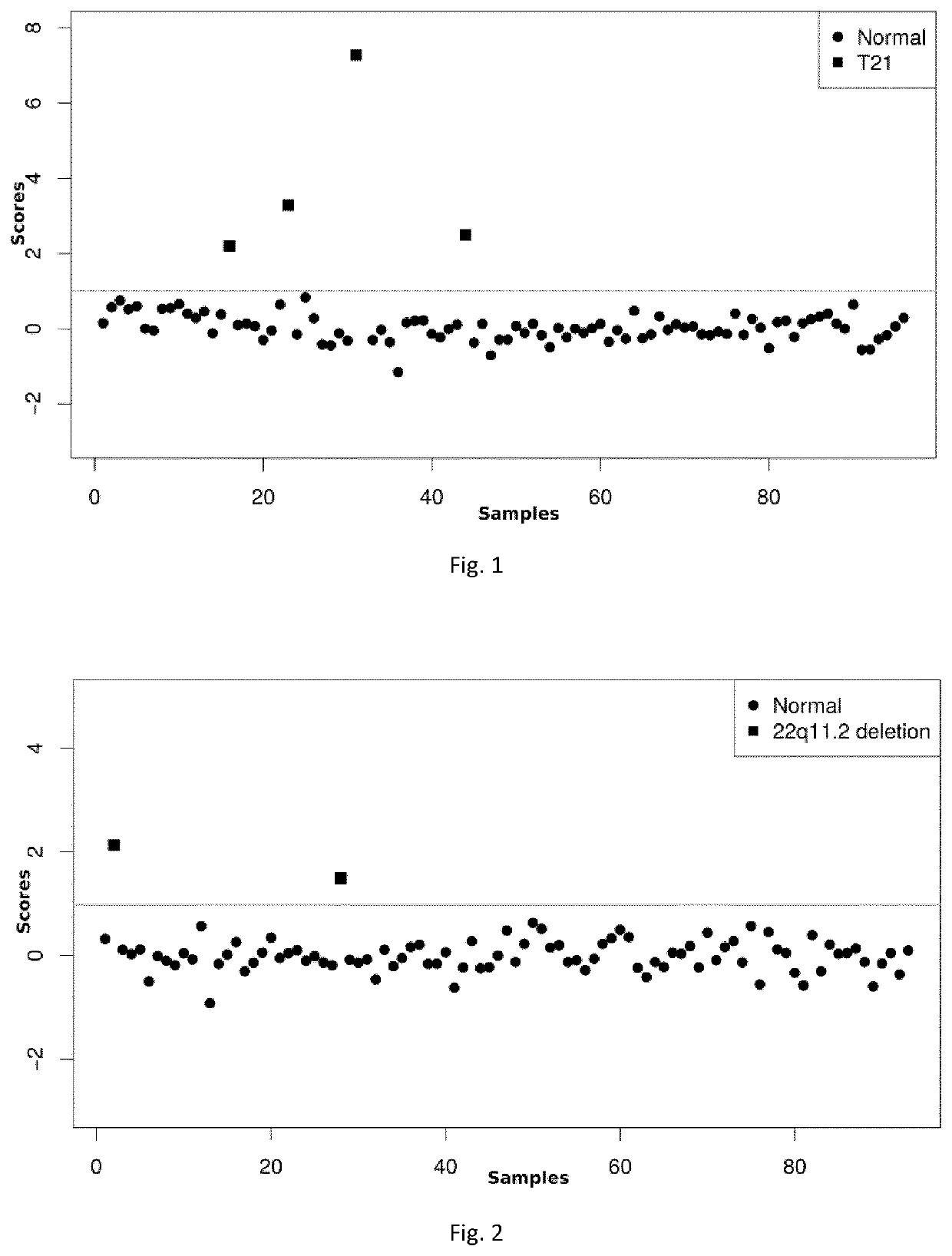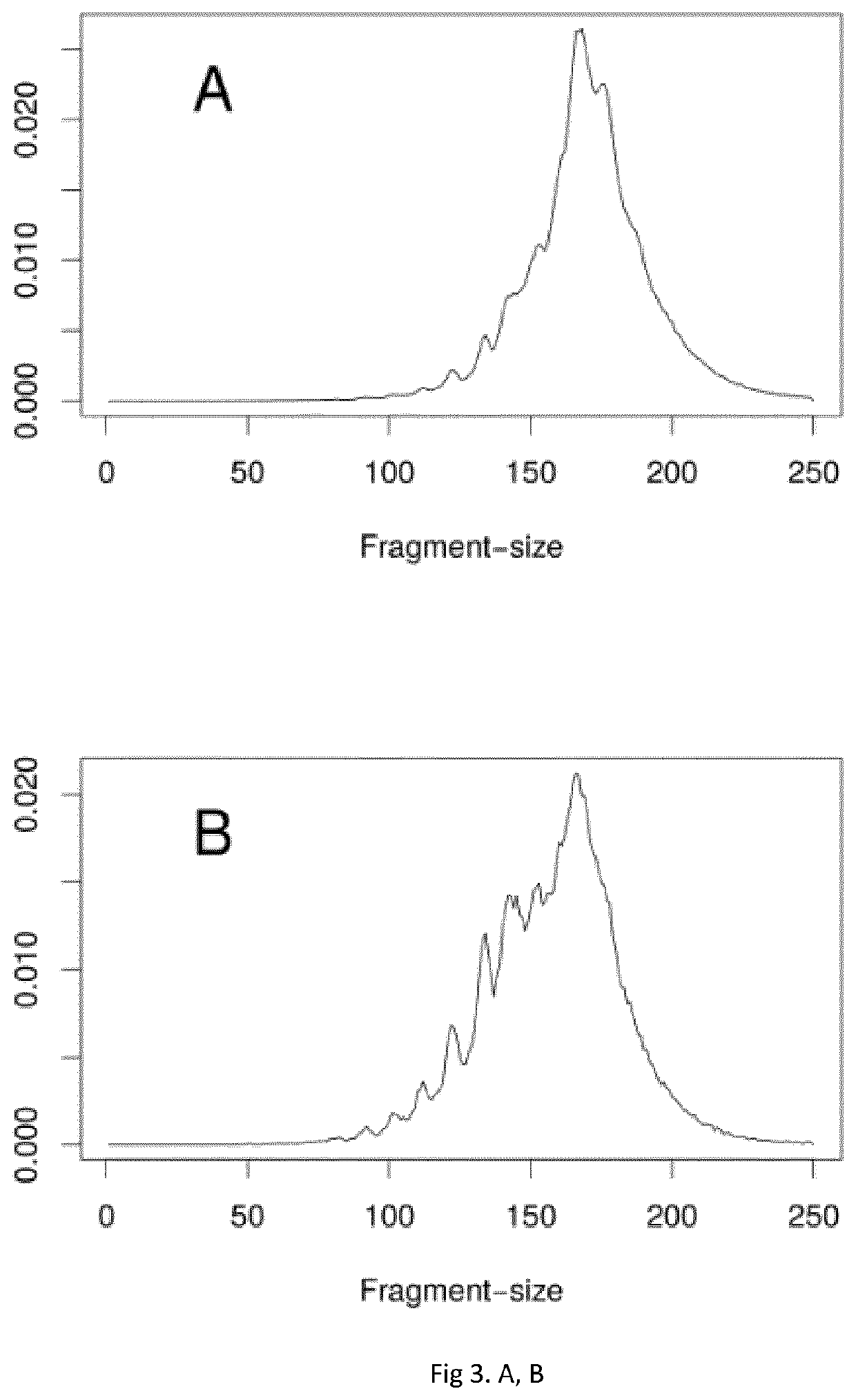Methods for noninvasive prenatal testing of fetal abnormalities
a non-invasive, fetal abnormality technology, applied in the field of molecular biology and molecular diagnostics, can solve the problems of challenging to obtain sufficient accuracy for non-invasive prenatal testing (nipt), and achieve the effect of high-sensitivity non-invasive detection of fetal abnormalities and increased signal-to-noise ratio
- Summary
- Abstract
- Description
- Claims
- Application Information
AI Technical Summary
Benefits of technology
Problems solved by technology
Method used
Image
Examples
example 1
llection and Library Preparation
[0123]The general methodology for the double enrichment of placenta derived DNA fragments in a mixed biological sample comprising fetal and maternal cell-free DNA for non-invasive prenatal diagnosis purposes is explained. In this example, methods for collecting and processing a maternal plasma sample (containing maternal and fetal DNA) are described. The same approach can be followed in other medically useful cases, such as, but not limited to oncology, genetic mutation, transplantation, and assessment of pathogen load. In another aspect, the same approach can be followed for the detection of epigenetic modifications.
[0124]Plasma samples were obtained anonymously from pregnant women after the 10th week of gestation. Protocols used for collecting samples were approved by the appropriate Bioethics Committee, and informed consent was obtained from all participants.
[0125]Cell-free DNA was extracted from plasma from each i...
example 2
ign and Preparation
[0127]This example describes preparation of custom probes for the detection of HSNRF. The genomic target-loci used for probes design were selected based on their GC content and their distance from repetitive elements (minimum 50 bp away). Probes size can be variable. In one embodiment of the method the probes range from 100-500 bp in size and are generated through a PCR-based approach. The probes were prepared by simplex PCR using standard Taq polymerase, primers designed to amplify the target-loci, and normal DNA used as template. In a preferred embodiment, the probe spans a HSNRF site such that only the 5′ end of the fragmented nucleic acid is captured by the probe. In another embodiment, the probe spans a HSNRF site such that only the 3′ end of the cell-free nucleic acids arising from HSNRF can bind to the probe. In another preferred embodiment, the probe spans both HSNRF sites associated with a fragmented nucleic acid such that both the 5′ and the 3′ end of a ...
example 3
ridization and Amplification
[0128]This example describes the method of target capture of nucleic acids by hybridization using probes, said probes preferably spanning HSNRF, followed by quantitation of captured sequences by Next Generation Sequencing (NGS).
Probe Biotinylation
[0129]Probes were prepared for hybridization, starting with blunt ending followed by purification. They were then ligated with a biotin adaptor and purified. Probes were denatured prior to immobilization on streptavidin coated magnetic beads.
Probe Hybridization
[0130]Amplified libraries were mixed with blocking oligos, Cot-1 DNA, Salmon Sperm DNA, hybridization buffer, blocking agent, and denatured. Denaturation was followed by 30 minutes incubation at 37° C. The resulting mixture was then added to the biotinylated probes and incubated for 12-48 hours at 60-70° C. After incubation, the enriched libraries were washed as described previously and DNA was eluted by heating. Eluted products were amplified using outer-b...
PUM
| Property | Measurement | Unit |
|---|---|---|
| Fraction | aaaaa | aaaaa |
| Fraction | aaaaa | aaaaa |
| Length | aaaaa | aaaaa |
Abstract
Description
Claims
Application Information
 Login to View More
Login to View More - R&D
- Intellectual Property
- Life Sciences
- Materials
- Tech Scout
- Unparalleled Data Quality
- Higher Quality Content
- 60% Fewer Hallucinations
Browse by: Latest US Patents, China's latest patents, Technical Efficacy Thesaurus, Application Domain, Technology Topic, Popular Technical Reports.
© 2025 PatSnap. All rights reserved.Legal|Privacy policy|Modern Slavery Act Transparency Statement|Sitemap|About US| Contact US: help@patsnap.com


